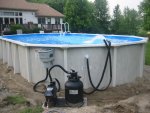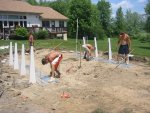I have been searching the internet for possible solutions to a recent problem that has occurred at our facilities. I came across TFP and was thoroughly impressed with the knowledge and communication skills of your chemistry experts. They are way beyond my knowledge so I am hoping they will be able to help me sort out the problem that has recently occourred that I cannot isolate.
I am responsible for 20 commercial indoor pools in seven facilities and, of late, we have been having the problem of ORP not tracking on three of the pools at three different locations. The complete automation system has been changed out on each of them without solving the problem and the manufacturer of the equipment has said it is a site problem. Two of these pools are over five years old but one is just over one year. Not all of the pools at a facility are affected to the point of not controlling ORP - some of the them are just slightly erratic. The automation has software that allows me to plot the sensor readings for the last two months. The plots show pH to be tightly controlled (almost a flat line) and in agreement with hand readings. The ORP plot shows sensor readings randomly and slowly driving with no relationship to FC hand readings. It is not unusual to see FC change by 8.0 ppm with a decrease in ORP. At the moment we are just turning the SWG's on and off as necessary to maintain FC levels.
All of our pools have high bather loads and we are open 24 hrs/day.
We have been using SWG's since 1996.
We do not use CYA in any of our pools.
All of our pools are automated (pH, ORP, heater control).
We have two brands of generators.
We use sand filters.
We generate bromine in our spas with standard SWG's.
We use sulfuric acid for pool pH control and CO2 for spa pH control (which is somewhat problematic).
We use monopersulfate weekly.
We remove phosphates from our water.
We have never had an algae problem.
We only rarely find it necessary to "shock" our pools. There is normally no chlorine odor in the air or a clorine smell on skin or hair.
Water systems in the area use chloride for system sanitation. In one location, CC test reads 3.0 on fill water; one system has 180 alkalinity incoming.
We have DHU's with pool-water reheat that supply adequate fresh air to the pool areas.
We have done prliminary checks of electrial systems and bonding connections. If this was an electrical or bonding/grounding/stray current problem would it not affect the pH sensor as well?
Do you see anything wrong with our chemistry?
Operating parameters:
FC 3.0 norm - 5.0 max (ORP set point at 760 @7.4 pH)
CC <.5
pH 7.4
Alk 80-100 (CO2)
Alk 80-120 (Acid)
CH 225-285
Salt 3000 - 3500 (older systems)
4000 - 5000 (newer systems)
Thanks for your help. This is a great site!
I am responsible for 20 commercial indoor pools in seven facilities and, of late, we have been having the problem of ORP not tracking on three of the pools at three different locations. The complete automation system has been changed out on each of them without solving the problem and the manufacturer of the equipment has said it is a site problem. Two of these pools are over five years old but one is just over one year. Not all of the pools at a facility are affected to the point of not controlling ORP - some of the them are just slightly erratic. The automation has software that allows me to plot the sensor readings for the last two months. The plots show pH to be tightly controlled (almost a flat line) and in agreement with hand readings. The ORP plot shows sensor readings randomly and slowly driving with no relationship to FC hand readings. It is not unusual to see FC change by 8.0 ppm with a decrease in ORP. At the moment we are just turning the SWG's on and off as necessary to maintain FC levels.
All of our pools have high bather loads and we are open 24 hrs/day.
We have been using SWG's since 1996.
We do not use CYA in any of our pools.
All of our pools are automated (pH, ORP, heater control).
We have two brands of generators.
We use sand filters.
We generate bromine in our spas with standard SWG's.
We use sulfuric acid for pool pH control and CO2 for spa pH control (which is somewhat problematic).
We use monopersulfate weekly.
We remove phosphates from our water.
We have never had an algae problem.
We only rarely find it necessary to "shock" our pools. There is normally no chlorine odor in the air or a clorine smell on skin or hair.
Water systems in the area use chloride for system sanitation. In one location, CC test reads 3.0 on fill water; one system has 180 alkalinity incoming.
We have DHU's with pool-water reheat that supply adequate fresh air to the pool areas.
We have done prliminary checks of electrial systems and bonding connections. If this was an electrical or bonding/grounding/stray current problem would it not affect the pH sensor as well?
Do you see anything wrong with our chemistry?
Operating parameters:
FC 3.0 norm - 5.0 max (ORP set point at 760 @7.4 pH)
CC <.5
pH 7.4
Alk 80-100 (CO2)
Alk 80-120 (Acid)
CH 225-285
Salt 3000 - 3500 (older systems)
4000 - 5000 (newer systems)
Thanks for your help. This is a great site!



